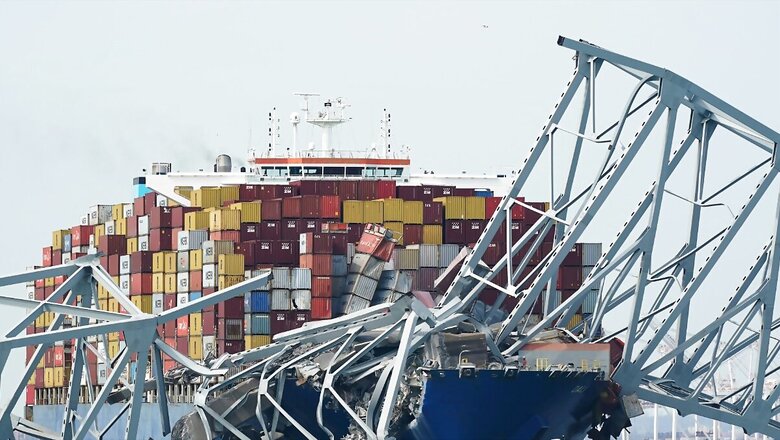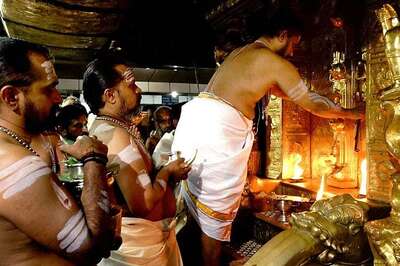
views
There is a “very long road ahead” to recover from the loss of Baltimore’s Francis Scott Key Bridge, Maryland Governor Wes Moore warned Thursday as the Biden administration approved $60 million in immediate federal aid after the deadly collapse.
This announcement came as the US Army engineers were moving the largest crane on the Eastern Seaboard to help remove the wreckage of the bridge to clear the channel and reopen the key shipping route. The machine, which can lift up to 1,000 tons, was expected to arrive Thursday evening. The state is “deeply grateful” for the federal funds and support, Moore said at an evening news conference.
Moore promised that “the best minds in the world” were working on plans to clear the debris, move the cargo ship that rammed into the bridge from the channel, recover the bodies of the four remaining workers presumed dead and investigate what went wrong. “Government is working hand in hand with industry to investigate the area, including the wreck, and remove the ship,” said Moore, a Democrat, who said the quick aid is needed to “lay the foundation for a rapid recovery.”
Join us for live updates on our ongoing response to the Key Bridge collapse: https://t.co/7DkdgS3atX— Governor Wes Moore (@GovWesMoore) March 28, 2024
Rebuilding cost
US President Joe Biden has pledged the federal government would pay the full cost of rebuilding the bridge. “This work is not going to take hours. This work is not going to take days. This work is not going to take weeks,” Moore said. “We have a very long road ahead of us.” US media reports said that the devastation left behind after the powerless cargo ship struck a support pillar early Tuesday is extensive.
Divers recovered the bodies of two men from a pickup truck in the Patapsco River near the bridge’s middle span Wednesday, but officials said they have to start clearing the wreckage before anyone could reach the bodies of four other missing workers. The crash caused the bridge to break and fall into the water within seconds. Authorities had just enough time to stop vehicle traffic, but didn’t get a chance to alert the construction crew.
State police have said that based on sonar scans, the vehicles appear to be encased in a “superstructure” of concrete and other debris. National Transportation Safety Board officials boarded the ship, the Dali, to recover information from its electronics and paperwork and to interview the captain and crew members. Investigators shared a preliminary timeline of events before the crash, which federal and state officials have said appeared to be an accident.
‘Best minds coming together’
“The best minds in the world are coming together to collect the information that we need to move forward with speed and safety in our response to this collapse,” Moore said Thursday. Of the 21 crew members on the ship, 20 are from India, External Affairs Ministry Spokesperson Randhir Jaiswal told reporters. One was slightly injured and needed stitches, but “all are in good shape and good health,” Jaiswal said.
The Dali, which is managed by Synergy Marine Group, was headed from Baltimore to Sri Lanka. It is owned by Grace Ocean Private Ltd. and was chartered by Danish shipping giant Maersk. Synergy extended sympathies to the victims’ families in a statement early Thursday. “We deeply regret this incident and the problems it has caused for the people of Baltimore and the region’s economy that relies on this vitally important port,” Synergy said, noting that it would continue to cooperate with investigators.
The huge vessel, nearly as long as the Eiffel Tower is tall, was carrying nearly 4,700 shipping containers, 56 of them with hazardous materials inside. Thirteen of those were destroyed, officials said. About 80 liters of oil from a bow thruster on the ship is believed to have caused a sheen in the waterway, Coast Guard Rear Adm. Shannon Gilreath said Thursday. Booms were placed to prevent any spreading, and state environmental officials were sampling the water.
Divers sent to work beneath the bridge debris and container ship will encounter challenging conditions, including limited visibility and moving currents. “Debris can be dangerous, especially when you can’t see what’s right in front of you,” said Donald Gibbons, an instructor with the Eastern Atlantic States Carpenters Technical Centers. The sudden loss of a highway that carries 30,000 vehicles a day and the port disruption will affect not only thousands of dockworkers and commuters but also US consumers.
(With agency inputs)




















Comments
0 comment